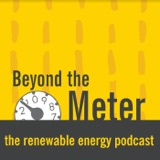
Beyond The Meter
Smart Energy Decisions
Podcast
Episodes
Listen, download, subscribe
Evolving Energy Strategies In Higher Ed - What's Next?
Institutes of higher education are large consumers of energy. From the lights and heat that are needed to keep students and faculty comfortable enough to learn effectively, to the equipment, technology, and staff required to keep things running, the expense is enormous. But for those same reasons, these institutions have a tremendous opportunity to push forward the move toward sustainable energy solutions, which will result in a cleaner environment and better future, and cost savings for them. Today, three guests from the realm of higher education join John for a frank conversation about the overall challenges faced by institutions of higher learning when it comes to renewable energy. Join John and his guests, Bill Guerrero of Ithaca College, Dennis Elliot of Cal Poly, and Wayne Johnson of Duke Energy for this enlightening conversation. You will want to hear this episode if you are interested in... The experience and background of our guests, leaders in Higher Education [0:55] A big-picture view: Energy management and sustainability in Higher Education [7:24] Some of the most productive investments in energy efficiency [16:38] The role of resiliency in energy solutions for Higher Education [24:12] How to pay for the improvements needed [32:56] Master Plans enable colleges & universities to plan toward sustainable energy There are vast differences in the way institutes of higher education make decisions and implement them when it comes to the capital improvements required to move toward sustainable and energy-efficient solutions for their campuses. The predominant way these institutions move the needle is through the inclusion of sustainability initiatives within the university or college’s Master Plan. These plans are revisited and revamped often because the situation on school campuses is changing all the time. New needs arise and circumstances demand new approaches. It’s a perfect opportunity to move their energy usage toward sustainable solutions. This conversation highlights the approach two leaders in higher education have taken when it comes to renewable energy improvements on campus. Cal Poly and Ithaca College have both focused on integrating sustainable energy improvements into their Master Planning process, with one of those schools even creating an independent energy Master Plan due to the increased importance of the issue. The issue of resiliency is of paramount importance for higher education The wildfires that have raged across California in 2020 illustrate one of the many reasons colleges and universities need to build resiliency into their energy procurement solutions. Cal Poly discovered that their energy solution was inadequate as a result of the fires. The institution relied on a sole provider and delivery mechanism that was endangered by the wildfires. The impact of a power loss is massive to facilities, educational systems, remote learning, and more. To address these issues, many opportunities exist to ensure power is not disrupted and education continues. Regional transmission systems with various substations are one solution, as are generators use in a synchronized fashion. On-site batteries can be used to implement load-shifting during peak energy consumption hours, and larger schools are looking into microgrids, co-generation, and combined heat and power sources. The most effective ways to fund energy improvements The COVID pandemic of 2020 has shown all of us that the economic conditions we enjoy one day may be in jeopardy the next. It’s an example of how various crises can shift the focus of an organization or institution to new areas, and environmental sustainability goals could be a regrettable casualty when this occurs. Add to that, the fact that many colleges face serious asset replacement issues shortly. 80% of schools surveyed say they plan on funding those capital improvements through increased enrollment, but because of the pandemic, full enrollment is not expected to happen for many years. The reality is that sustainability initiatives compete with every other need at institutions of higher learning, and the assets needed for energy projects are behind-the-scenes and not as easily noticed as the other more superficial things like paint, carpet, landscaping, and building facades. Those in charge of energy, facilities, and capital improvements have their work cut out for them in trying to gain the buy-in for energy improvements and upgrades during such times. But it’s entirely possible, and our guests give many helpful suggestions about how to position your budget requests in ways that enthuse and engage your stakeholders. Resources & People Mentioned Ithaca College California Polytechnic Institute Connect With Our Guests Bill Guerrero, Vice President for Finance and Administration, Ithaca College Bill has served in the education industry for over 21 years in education and independent schools. Ithaca College is a Private, Residential, Liberal Arts College with about 5,800 students and 1,700 faculty/staff. Bill’s areas of responsibility are Finance & Accounting, Auxiliary Services, Information Technology, and Facilities Services including Environmental Sustainability. With 2.6 M feet of space, the majority of which was built in the 1950s and 1960s, Ithaca’s initiatives have secured it the AASHE Gold Star Rating. The Environment America Research & Policy Center ranks Ithaca College #8 in percent of electricity derived from renewable resources. Follow Bill on LinkedIn Dennis Elliot, Director of Energy, Utilities, and Sustainability, California Polytechnic State University, San Luis Obispo. Dennis Elliot serves as the Director of Energy, Utilities, and Sustainability in the Facilities Management and Development Department at California Polytechnic State University, San Luis Obispo. Dennis holds a bachelor's degree from Cal Poly in Mechanical Engineering, is a licensed Professional Engineer in the state of California, and a Certified Energy Manager. In his 37 years at Cal Poly in a variety of energy-related roles, Dennis has helped lead operation and maintenance of building HVAC and central plants; design, construction, and commissioning of new buildings and utility systems; utility metering, building automation, SCADA, and building data analytic systems; energy and water conservation programs; renewable energy projects; sustainability educational outreach and curriculum infusion initiatives; LEED Certification and AASHE STARS programs; Master Planning and Strategic Planning; Zero Waste Programs and the campus' Climate Action Plan. Dennis helped found and still mentors Cal Poly's Green Campus Program of student peer educators, serves on Cal Poly’s Academic Senate Sustainability Committee, and chairs the campus Sustainability Advisory Committee. Follow Dennis on LinkedIn Wayne Johnson, Duke Energy’s Key Segment Manager For EducationWayne has served as a Facilities Management and Energy Executive in Higher Education and brings a wealth of experience to Duke Energy. Wayne has also managed safety and accreditation processes for his campus and has provided oversight and program responsibility for a regional K-12 outsourced facilities management firm. Wayne has a passion for “out of the box” thinking that generates a creative process in meeting the challenges facing energy infrastructure and asset management in education. Wayne strives to create a “synergy” that builds solutions to meet the needs of all campus constituents: Facilities leaders, CFOs, Presidents, Head of School, faculty, staff, students, and local communities. His unique perspective and experience when combined with Duke Energy’s ability to execute can be of great support as schools look to become energy efficient, sustainable, and viable for the future. Wayne enjoys international travel, time on the lake and hiking, especially when his extended family and wife can join in the adventure. Wayne has worked as a licensed electrical and general contractor and has degrees from Mars Hill University and The University of South Carolina where his advanced degree is in Education Administration. Follow Wayne on LinkedIn Connect With Smart Energy Decisions https://www.smartenergydecisions.com/ Follow them on Facebook Follow them on Twitter Follow them on LinkedIn Subscribe to Beyond The Meter on Apple Podcasts, Spotify, Google Podcasts
Beyond The Meter RSS Feed

